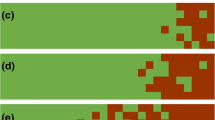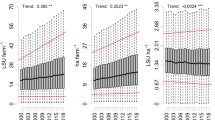Abstract
The increase in the speed of land-cover change experienced worldwide is becoming a growing concern. Major socio-economic transitions, such as the breakdown of socialism in Europe, may lead to particularly high rates of landscape transformations. In this paper we examined the loss of semi-natural grasslands in Hungary between 1987 and 1999. We studied the relationship between 9 potential driving forces and the fate of grasslands using logistic GLMs. Grassland loss was found to be very high (1.31 % per year), which is far higher than either before or after this period. The most influential predictors of grassland loss were environmental and landscape characteristics (soil type, area of remnant grassland patches), and the socio-economic context (distance to paved road, and nearest settlement, human population density). Several processes and relationships can only be understood from a historical perspective (e.g. large extent of afforestation, strong decrease of soil water table). Grassland loss during the study period emerged as a consequence of survival strategies of individual farmers seeking adaptation to the changing environmental and socio-economic conditions, and not urbanization and agricultural intensification which are the main underlying drivers for the ongoing landscape transformations in most parts of the developed world. Though globalization increasingly influences local land use decisions, reconstructing and modelling recent landscape changes cannot be done without a proper understanding of local history and culture. Our analysis shows the importance of large-area yet high resolution landscape change research, which may reveal unexpected patterns of land cover change, undetected at coarser scales.



Similar content being viewed by others
References
Antrop M (2005) Why landscapes of the past are important for the future. Landsc Urban Plan 70:21–34
Baumann M, Kuemmerle T, Elbakidze M, Ozdogan M, Radeloff VC, Keuler NS, Prishchepov V, Kruhlov I, Hostert P (2011) Patterns and drivers of post-socialist farmland abandonement in Western Ukraine. Land Use Policy 28:552–562
Bičík I, Jeleček L, Štěpánek V (2001) Land-use changes and their social driving forces in Czechia in the 19th and 20th centuries. Land Use Policy 18:65–73
Biró M (2000) Actual habitat map of the Danube-Tisza Interfluve. Database, Institute of Ecology and Botany, Vácrátót, Hungary
Biró M (2011) Változástérképek használata tíz év alatt bekövetkezett élőhelypusztulási tendenciák kimutatására a Kiskunsági-homokhátság területén. Tájökol Lap 9:357–374
Biró M, Révész A, Horváth F, Molnár Zs (2006) Point based mapping of the actual vegetation of a large area in Hungary—description, usability and limitation of the method. Acta Bot Hung 48:247–269
Biró M, Révész A, Molnár Zs, Horváth F, Czúcz B (2008) Regional habitat pattern of the Duna-Tisza köze in Hungary II. The sand, the steppe and the riverine vegetation; degraded and ruined habitats. Acta Bot Hung 50:21–62
Burger A (2001) Agricultural development and land concentration in a central European country: a case study of Hungary. Land Use Policy 18:259–268
Bürgi M, Hersperger AM, Schneeberger N (2004) Driving forces of landscape change—current and new directions. Landscape Ecol 19:857–868
CORINE LC (2000) CORINE land cover map of Hungary, scale: 1:50 000. GIS Database, FÖMI, Budapest, Hungary. http://www.fomi.hu/corine/
Cramer VA, Hobbs RJ, Standish RJ (2008) What’s new about old fields? Land abandonment and ecosystem assembly. Trends Ecol Evol 23:104–112
Csatári B (2006) Country visions in East Central Europe. In: Kovács AD (ed) Regionality and/or locality. Center for Regional Studies of the Hungarian Academy of Sciences, Pécs, pp 194–200
Csatári B, Farkas J (2008) Agrarian and rural developments in Hungary, 1990–2005. In: Bańsky J, Bednarek M (eds) Contemporary changes of agriculture in East-Central Europe. Polish Academy of Sciences Institute of Geography and Spatial Organization—Polish Geographical Society, Warsaw, pp 147–164
Czúcz B, Révész A, Horváth F, Biró M (2005) Loss of semi-natural grasslands in the Hungarian forest steppe zone in the last fifteen years: causes and fragmentation patterns. In: McCollin D, Jackson JI (eds) Planning, people and practice: the landscape ecology of sustainable landscapes. Proceedings of the 13th annual IALE (UK) conference. University of Northampton, pp 73–80
Czúcz B, Csecserits A, Botta-Dukát Z, Kröel-Dulay G, Szabó R, Horváth F, Molnár Zs (2011) An indicator framework for the climatic adaptive capacity of natural ecosystems. J Veg Sci 22(4):711–725
DTA50: Digital Mapping Database (1:50 000 scale), Ministry of Defence, Budapest, Hungary, http://www.topomap.hu
Falcucci A, Maiorani L, Boitani L (2007) Changes in land-use/land-cover patterns in Italy and their implications for biodiversity conservation. Landscape Ecol 22:617–631
Feranec J, Šúri M, Ot’ahel’ J, Cebecauer T, Kolář J, Soukup T, Zdeňková D, Waszmuth J, Vâjdea V, Vĭjdea AM, Nitica C (2000) Inventory of major landscape changes in the Czech Republic, Hungary, Romania and Slovak Republic 1970s–1990s. Int J Appl Earth Obs 2:129–139
Feranec J, Hazeu G, Christensen S, Jaffrain G (2007) Corine land cover change detection in Europe (case studies of the Netherlands and Slovakia). Land Use Policy 24:234–247
Feranec J, Jaffrain G, Soukup T, Hazeu G (2010) Determining changes and flows in European landscapes 1990–2000 using CORINE land cover data. Appl Geogr 30:19–35
Foley JA, DeFries R, Asner G, Barford C, Bonan G, Carpenter SR, Chapin FS, Coe MT, Daily GC, Gibbs HK, Helkowski JH, Holloway T, Howard EA, Kucharik CJ, Monfreda C, Patz JA, Prentice IC, Ramankutty N, Snyder PK (2005) Global consequences of land use. Science 309:570–574
Fox J, Monette G (1992) Generalized collinearity diagnostics. J Am Stat Assoc 87:178–183
Geist HJ, McConnell WJ, Lambin EF, Moran E, Alves D, Rudel T (2006) Causes and trajectories of land use/cover change. In: Lambin EF, Geist HJ (eds) Land use and land cover change. Local processes and global impacts. Springer, Berlin, pp 41–70
Gimmi U, Lachat T, Bürgi M (2011) Reconstructing the collapse of wetland networks in the Swiss lowlands 1850–2000. Landscape Ecol 26:1071–1083
Haan CT (2002) Statistical methods in hydrology, 2nd edn. Iowa State University Press, Ames
Hatna E, Bakker MM (2011) Abandonment and expansion of arable land in Europe. Ecosystems 14:720–731
Hersperger AM, Bürgi M (2009) Going beyond landscape change description: quantifying the importance of driving forces of landscape change in a Central European case study. Land Use Policy 26:640–648
Hietel E, Waldhardt R, Otte A (2005) Linking socio-economic factors, environment and land cover in the German Highlands, 1945–1999. J Environ Manage 75:133–143
Kertész M, Kelemen E, Biró M, Kovács-Láng E, Kröel-Dulay G (2011) Ecosystem services and disturbance regime as linkages between environment and society in the Kiskunság region. In: Nagy GG, Kiss V (eds) Borrowing services from nature—methodologies of ecosystem services based on Hungarian case studies. CEEweb for Biodiversity, Budapest, pp 91–110
Kovács Székely I, Szalai J (2009) The impact of climate change on production of Hungarian agriculture, especially on shallow groundwater supply. Proceedings of Budapest Business School, Budapest, pp 79–96
Kovács-Láng E, Molnár E, Kröel-Dulay G, Barabás S (eds) (2008) The KISKUN LTER: long-term ecological research in the Kiskunság, Hungary. Institute of Ecology and Botany, Vácrátót
Kreybig Soil Map (1934–1944) Kreybig digital database and information system. Research Institute for Soil Science and Agricultural Chemistry, Budapest, Hungary
KSH: Hungarian Central Statistical Office Database, Budapest, Hungary http://portal.ksh.hu/portal/page?_pageid=38,447568&_dad=portal&_schema=PORTAL
KSH ÁMÖ (2000) Agriculture in Hungary, 2000—data by settlements and territorial data. Official CD version. Hungarian Central Statistical Office, Budapest
Kuemmerle T, Hostert P, Radeloff VC, Perzanowski K, Kruhlov I (2007) Post-socialist forest disturbance in the Carpathian border region of Poland, Slovakia, and Ukraine. Ecol Appl 17:1279–1295
Kuemmerle T, Müller D, Griffiths P, Rusu M (2008) Land use change in Southern Romania after the collapse of socialism. Reg Environ Change 9:1–12
Lakes T, Müller D, Krüger C (2009) Cropland change in southern Romania: a comparison of logistic regressions and artificial neural networks. Landscape Ecol 24:1195–1206
Lambin EF, Turner BL, Geist HJ, Agbola SB, Angelsen A, Bruce JW, Coomes OT, Dirzo R, Fischer G, Folke C, George PS, Homewood K, Imbernon J, Leemans R, Li X, Moran EF, Mortimore M, Ramakrishnan PS, Richards JF, Skånes H, Steffen W, Stone GD, Svedin U, Veldkamp TA, Vogel C, Xu J (2001) The causes of land-use and land-cover change: moving beyond the myths. Glob Environ Chang 11:261–269
Lepers E, Lambin EF, Janetos AC, DeFries R, Achard F, Ramankutty N, Scholes RJ (2005) A synthesis of information on rapid land-cover change for the period 1981–2000. Bioscience 55:115–124
Łowicki D (2008) Land use changes in Poland during transformation, case study of Wielkopolska region. Landsc Urban Plan 87:279–288
Main-Knorn M, Hostert P, Kozak J, Kuemmerle T (2009) How pollution legacies and land use histories shape post-socialist forest cover trends in the Western Carpathians. Forest Ecol Manag 258:60–70
Marcucci DJ (2000) Landscape history as a planning tool. Landsc Urban Plan 49:67–87
Molnár Zs (ed) (2003) A Kiskunság száraz homoki növényzete. (Sand dunes of Hungary.) TermészetBÚVÁR Alapítvány Kiadó, Budapest
Molnár Zs, Biró M, Bartha S, Fekete G (2012) Past trends, present state and future prospects of hungarian forest-steppes. In: Werger MJA, van Staalduinen MA (eds) Eurasian steppes. Ecological problems and livelihoods in a changing world. Springer, Dordrecht, pp 209–252
Monteiro AT, Fava F, Hiltbrunner E, Della Marianna G, Bocchi S (2011) Assessment of land cover changes and spatial drivers behind loss of permanent meadows in the lowland of Italian Alps. Landsc Urban Plan 100:287–294
Nassauer JI (1995) Culture and changing landscape structure. Landscape Ecol 10:229–237
Palang H, Printsmann A, Konkoly Gyuró É, Urbanc M, Skowronek E, Woloszyn W (2006) The forgotten rural landscapes of Central and Eastern Europe. Landscape Ecol 21:347–357
R Development Core Team (2011) R: A language and environment for statistical computing. R Foundation for Statistical Computing, Vienna, Austria. ISBN 3-900051-07-0. URL http://www.R-project.org/
Révész A, Czúcz B, Horváth F (2004) A települések és az úthálózat szerepe a Duna-Tisza közi természetközeli gyepek pusztulásában. I. Magyar Tájökológiai Konferencia: végleges program, összefoglalók, résztvevők listája, SZIE KTI, Gödöllő, p 59
Rudel TK (1998) Is there a forest transition? Deforestation, reforestation, and development. Rural Sociol 63:533–552
Schneeberger N, Bürgi M, Hersperger AM, Ewald KC (2007a) Driving forces and rates of landscape change as a promising combination for landscape change research—an application on the northern fringe of the Swiss Alps. Land Use Policy 24:349–361
Schneeberger N, Bürgi M, Kienast FPD (2007b) Rates of landscape change at the northern fringe of the Swiss Alps: historical and recent tendencies. Landsc Urb Plan 80:127–136
Süli-Zakar I (1999) Socio-geographical transition in the rural areas of the Carpathian Euroregion. GeoJournal 46:193–197
Temme AJAM, Verburg PH (2011) Mapping and modelling of changes in agricultural intensity in Europe. Agr Ecosyst Environ 140:46–56
TIR: Database of the Nature Conservation Information System of Hungary. Ministry of Rural Development, Budapest, Hungary. http://geo.kvvm.hu/tir_en/
Verburg PH, Eickhout B, van Meijl H (2008) A multi-scale, multi-model approach for analyzing the future dynamics of European land use. Ann Reg Sci 42:57–77
Vitousek PM, Mooney HA, Lubchenco J, Melillo JM (1997) Human domination of Earth’s ecosystems. Science 277:494–499
VITUKI database: Water Resources Research Centre, Hungary, Budapest. http://www.vituki.hu/
Zuur AF, Ieno EN, Elphick CS (2010) A protocol for data exploration to avoid common statistical problems. Methods Ecol Evol 1:3–14
Acknowledgments
We would like to express our thanks to Jenő Zsolt Farkas, András Iványosi Szabó, and Zoltán Vajda for their help in gathering adequate data for our analysis, to the two editors, and the two anonymous reviewers for their suggestions, and Edwin Divall for English revision.
Author information
Authors and Affiliations
Corresponding author
Electronic supplementary material
Below is the link to the electronic supplementary material.
10980_2012_9818_MOESM1_ESM.txt
Electronic appendix: ANOVA tables containing AIC, χ2 and p-values for single term additions and single term deletions, as well as the coefficients for each term in the best model for each type of grassland loss (TXT 12 kb)
Rights and permissions
About this article
Cite this article
Biró, M., Czúcz, B., Horváth, F. et al. Drivers of grassland loss in Hungary during the post-socialist transformation (1987–1999). Landscape Ecol 28, 789–803 (2013). https://doi.org/10.1007/s10980-012-9818-0
Received:
Accepted:
Published:
Issue Date:
DOI: https://doi.org/10.1007/s10980-012-9818-0




